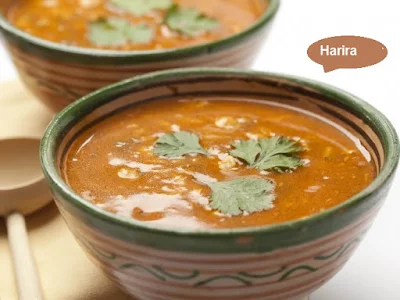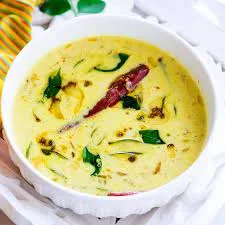 |
| Haira The Moroccan Soup |
Here’s a
traditional recipe for Harira, the Moroccan soup that’s perfect for
Ramadan:
Ingredients:
- 225gms of lamb,
beef, or chicken, diced
- 3 tablespoons
of olive oil or vegetable oil
- Soup bones
(optional)
- 900 gms of ripe
tomatoes (about 6 large), pureed
- 1 handful of
dry chickpeas, soaked and peeled
- 2 handfuls of
brown or green lentils
- 1 large onion,
grated
- 1 stalk of
celery with leaves, chopped
- 1 small bunch
of flat-leaf parsley, finely chopped
- 1 small bunch
of cilantro, finely chopped
- 1 tablespoon of
smen (optional)
- 1 tablespoon of
salt
- 1 tablespoon of
ginger
- 1½ teaspoons of
black pepper
- 1 teaspoon of
ground cinnamon (optional)
- ½ teaspoon of
turmeric
- 3 tablespoons
of tomato paste (mixed with 1 or 2 cups of water)
- 3 tablespoons
of broken vermicelli or uncooked rice
- 1 cup of flour
(mixed with 2 cups of water for the tedouira)
- Lemon wedges
and additional cilantro for garnish (optional)
(A tedouira is a thickening agent used in Moroccan
cuisine, particularly in the popular soup Harira. It's essentially a flour and
water mixture, sometimes fermented with yeast for a day or two [1]. This
fermentation adds a slightly sour flavor to the soup.)
Instructions:
- In a large pot,
heat the oil and brown the meat along with any soup bones.
- Add the grated
onion, celery, parsley, cilantro, and spices, stirring until fragrant.
- Pour in the
pureed tomatoes and tomato paste mixture, then add the chickpeas and
lentils.
- Cover with
water and bring to a boil. Reduce heat and simmer until the chickpeas and
lentils are tender.
- Prepare the
tedouira by mixing the flour with water until smooth. Gradually stir into
the soup to thicken.
- Add the
vermicelli or rice and cook until tender.
- Adjust
seasoning to taste and serve hot, garnished with lemon wedges and
additional cilantro if desired.
Enjoy your Harira and have a blessed Ramadan!








